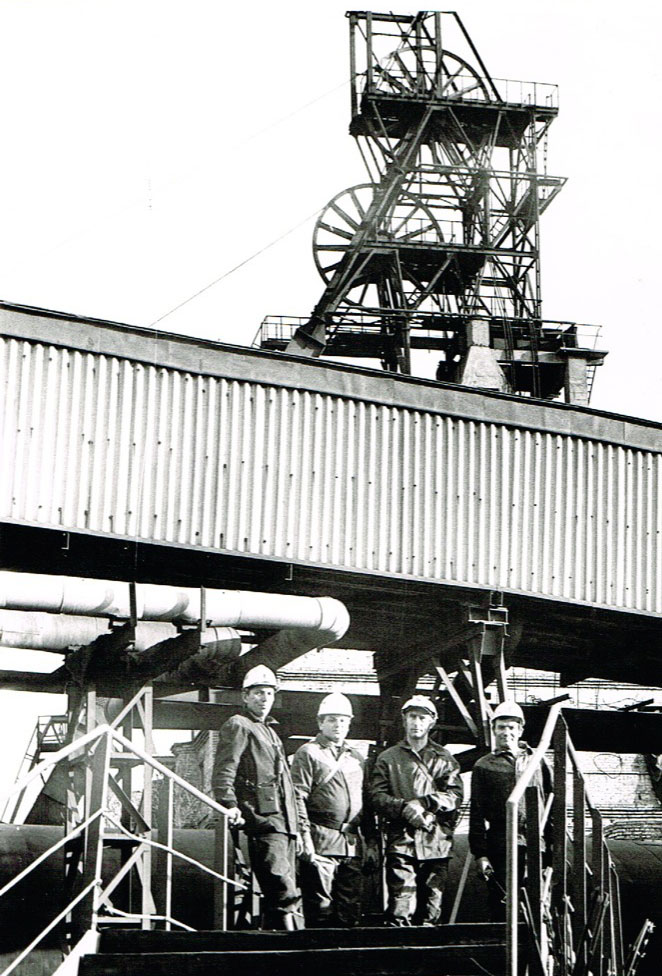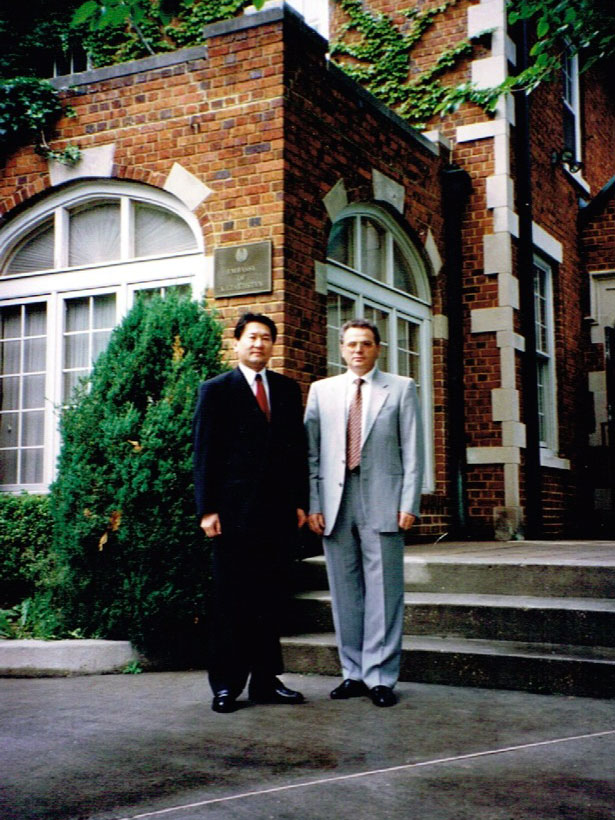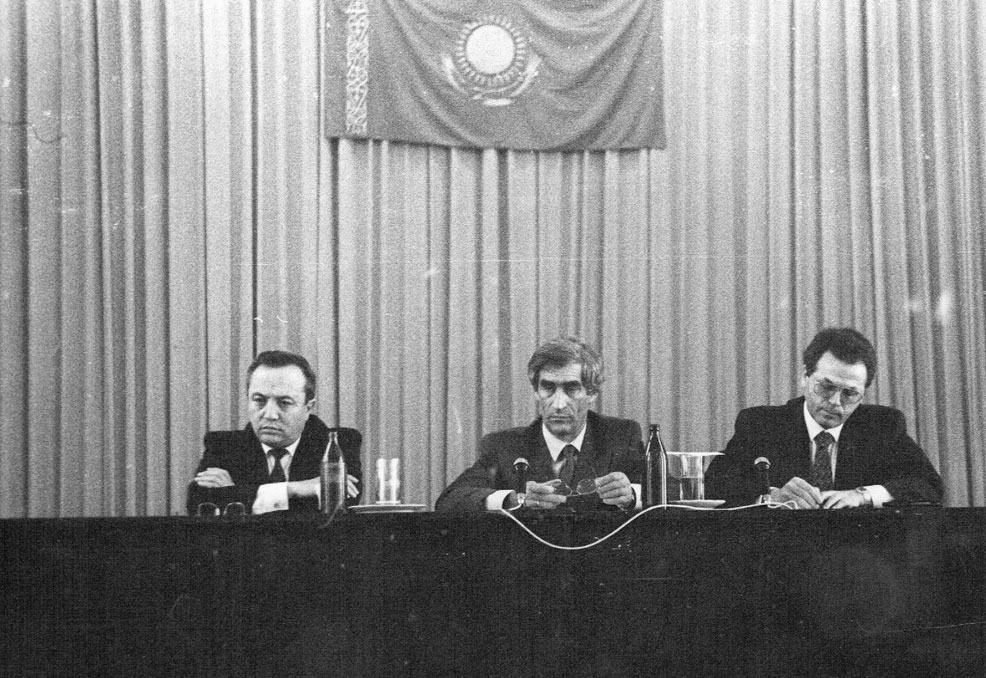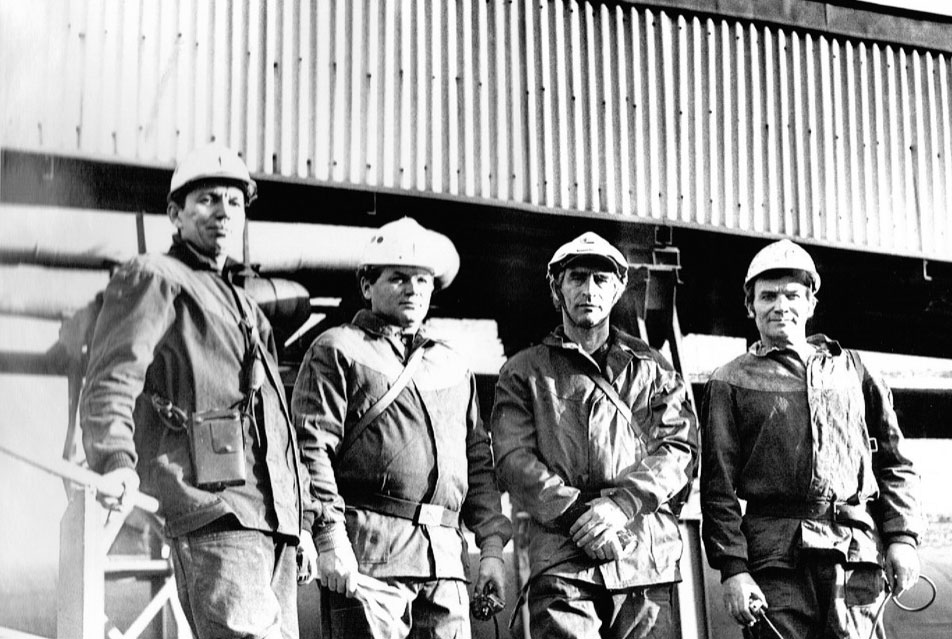Years as Minister of Energy
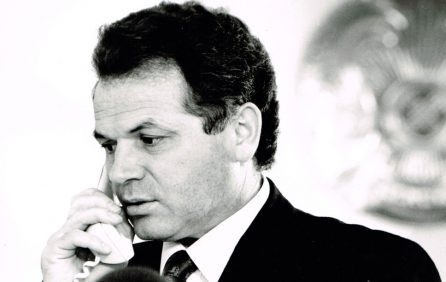
In March 1995, Viktor Khrapunov was appointed to the position of Minister of Energy and Mining. From March to mid-June 1997, following an important reform in the government, he found himself at the leadership of an expanded Ministry for a short period of time: two formerly independent ministries (Geology, and Petroleum and Natural Gas) were added to his portfolio.
His first ministerial post allowed Viktor Khrapunov to return to his roots as an engineer. In the mid-1980s, he had been responsible for producing and distributing electrical and thermal energy through the city of Almaty. A decade later, he accepted a similar responsibility, but this time on a countrywide scale as minister.
When he took over the Ministry of Energy, the country was on the edge of energy asphyxiation. The old habits of the Soviet regime still dominated. In particular, it was very difficult to obtain payment for the electrical bills of large industrial consumers. Consequently, the Ministry of Energy sorely lacked the means to maintain, rebuild and develop the existing infrastructure, which suffered from extreme dilapidation – about 60% of power plants were in a state of advanced disrepair. Furthermore, the Ministry had accumulated colossal debts towards its neighboring countries, which had supplied it with energy. For example, in 1995, Kazakhstan’s debts to Russian energy companies alone rose to 450 million dollars.
The problems of the era were reflected in statistics. Following the independence of the country, domestic electrical production capacity decreased by more than a third within a few years, going from 88 GWh (the electrical power necessary to cover the needs of the country) to 66 GWh. For comparison, in 1986, under the Soviet regime, when the Kazakh industry was operating at full speed, consumption hit a record of 104 GWh (purchasing electricity from abroad to cover the difference beyond the domestic production of 88 GWh).
The electrical infrastructures that Viktor Khrapunov inherited were thus an accumulation of every weakness: they were dilapidated, unstable, indebted and incapable of ensuring basic supply for a population that suffered its consequences every day. It must be said that in a country like Kazakhstan, energy supply poses a logistical challenge. It entails covering the needs of a region that is relatively sparsely populated (15 million inhabitants) but that is also extremely vast (five times the area of France). During the first half of the 1990s, following the breakup of the Soviet Union, the central government was incapable of assuming its responsibilities. For lack of money, energy producers could no longer buy the fuel and other components necessary to supply the population and the economy. This shortage resulted in automatic disconnections, leading to power outages in the homes of private consumers. The minister had to introduce rationing measures throughout the entire country. Scheduled blackouts affected both those who paid their bills and those who did not pay them. Unfortunately, this was an unavoidable measure- neighborhood by neighborhood, electricity was shut off for up to six hours a day, during which pumps did not work and water was also unavailable.
In an attempt to solve the problem, the ministers preceding Viktor Khrapunov went on to raise prices. However, this measure did not improve the situation. In fact, it was counterproductive: frustrated by a low-quality service, consumers felt even more entitled not to pay their electricity bills, which were deemed exorbitant, making the financial situation of the Ministry even worse. Fearing that the population’s discontent could result in an uprising, the Prime Minister of Kazakhstan went as far as to declare that the population was free not to pay bills issued by energy companies. He had a government ordinance passed, legalizing non-payment of bills for energy consumption. The situation was unmanageable and completely chaotic.
Surrounding himself with specialists, Viktor Khrapunov took a different approach to tackle the problem. He developed a general project to reform the energy industry and presented it to the Kazakh government, which accepted it on May 30, 1996. First of all, this program included a new distribution of responsibilities between central and local authorities in matters related to the supply of electrical and thermal energy: control of the infrastructure remained centralized at the ministry but alllocal leaders (regional and municipal) became responsible for the supply in their respective territories. Suddenly, local authorities had to assume responsibility for power outages in front of the population – and they could no longer transfer the responsibility to the central ministry as in the past. This resulted in a strong incentive to stop letting local companies that did not pay their bills go unpunished. This way, the first goal of the Khrapunov reform was achieved: revenue went up.
The second part of the program included the following measures:
- Implementation of a central operator in charge of regulating energy supply at the national level, of controlling the execution of supply contracts, and of representing Kazakhstan during negotiations with foreign energy companies. The company KEGOK (Kazakhstan Electric Grid Operation Company) was created for this purpose.
- The nine largest power plants in the country had to remain in the hands of the government:
- Four hydroelectric plants: Bukhtarma, Ust-Kamenogorsk and Shulbinsk on the Irtysh river, as well as Kaptchagay on the Ily river
- Four thermoelectric plants: Ekibastuz 1 and 2, Aksuy and Karaganda 2 (powered by solid fuel).
- The national regional plant of Dzhambul (powered by gas)
- Regulation of the electricity market. Following the creation of basic laws and regulations in this field, the market began to operate.
- The creation of a market to trade electricity.
- Privatization of small producers of electricity and small companies in charge of the distribution of electricity.
It is important to specify that denationalization and privatization in Kazakhstan were managed by bodies created for that purpose, namely the National Authority of Public Assets and the Committee for Privatization of Public Assets, which depended directly upon the President and the Prime Minister. The Minister of Energy and Mines presided with 14 more members at these institutions and, because of this, he could not prevent a privatization that had already been decided from taking place.
Through the use of market laws, this measure sought to introduce a certain level of competition among different electricity producers, as well as among electricity distribution companies. This resulted in better management of infrastructures and, consequently, in increased production capacity, which was the second goal of the Khrapunov reform.
The reform voted in May 1996 quickly paid off. By stabilizing the energy sector, it supported the transition between a planned system and a market economy, which was still in its infancy. Energy producers, transporters, and distributors were separated from one another. Competition between economic players started to play its role, resulting in more transparent billing for consumers, who could now freely choose their providers and distributors. Once the crisis was overcome, the energy infrastructures of the country became tempting prey for president Nazarbayev, who did not wait long to take an interest in them.
This is the essential reason why the reform failed. Viktor Khrapunov wanted to limit the privatization of the energy industry to small companies and to leave the government in control of the largest hydroelectric plants in the country, which represented 20% of all power plants but 50% of total production capacity. In his opinion, this aspect should not have been subject to any speculation. This was aimed at preserving the most important energy supply for the country in the public domain so as to protect the best interest of the country, namely its ability to provide electricity to its entire national territory completely independently, regardless of the financial or political situation either in the country or abroad. This decision promoting a high degree of energy independence also had a social aspect to it: power outages presented many serious problems to the most disadvantaged portions of the population. Therefore, it was in the interest of the government to remain sovereign in this aspect so as to cover the basic needs of the entire population living within its borders.
As minister, Viktor Khrapunov fiercely opposed the privatization of the most important power plants in the country. However, his efforts could not measure up to the appetite of the President of the Republic. Through directives sent directly to the Prime Minister, without consulting the minister in charge of the matter, the president dismantled this set of power plants, piece by piece. Knowing that his minister was opposed to the sales, he went around him and had the National Authority on Public Assets and the National Authority for Privatizations intervene. Although he was a member of the government, the Minister of Energy only saw some government rulings once they had already been signed. In those cases, he could only confirm a sale that had already taken place.
In this way, in violation of the reform of May 1996 voted by the government, Nursultan Nazarbayev had all the most powerful power plants in the country transferred to members of his family or to companies affiliated to them, one by one. To this day, Viktor Khrapunov can bear witness to these facts. He can recount how the energy resources of the countryvalued at billions of dollars were sold off for a few million. Here are some examples:
- The regional electrical power plant of Ermakovsk was transferred to the Eurasian group in 1996
- The Karaganda No. 2 thermoelectric plant (400 MW) was transferred to Mittal (Indian oligarch residing in London) in 1996
- Kaz’zinc (belonging to Glencore) acquired Bukhtarma, the most powerful plant in the country (500 MW) in 1997
- The hydroelectric plants of Ust-Kamenogorsk (150 MW) and Shulbinsk (700 MW) were transferred to AES in September 1997 for about 5 million dollars
- The Dzhambul hydroelectric plant (1200 MW) was transferred to Timur Kulibayev in 1999
- The Balkhash thermoelectric plant (70 MW) was transferred to the company Kazakmys in 1998
- The Karaganda 2 regional electric plant (500 MW) was transferred to the company Kazakmys in 1996
- The Dzhezkazgan thermoelectric plant (120 MW) was transferred to Kazakmys in 1997
- The Kaptchagay hydroelectric plant (460 MW) was transferred to Tractebel in 1997
- The Ekibastuz N 1 regional electric plant (4000 MW) was transferred to AES in 1997 for about 5 million dollars
- In 2006, Nursultan Nazarbayev purchased the Ekibastuz 1 regional electric plant for 2 billion dollars – a huge money laundering operation.
The selling off of energy resources was a scandal of personal money gain. For the Kazakh population, it also represented an unacceptable spoliation with very serious financial consequences, not only every time that part of the national patrimony was liquidated at a pittance but also in the medium and long term during the operation of these facilities by their new owners. This represented a loss in revenue of billions of dollars which, instead of going into the government’s coffers, made the Nazarbayev clan rich.
The case of the Buktharma plant illustrates this phenomenon well. Around the 1960s, the entire Soviet Union had participated in the construction of a dam with a height of 90 meters. An enormous amount of resources was used. Even today, this hydroelectric plant has the 20th largest reservoir in the world. put in service in 1964, these facilities could have made up for all of the investment granted for their construction within 25 years of operation. Excluding maintenance, their costs were practically none, making them an extremely profitable business, from which the Kazakh population ought to have benefitted. However, Nursultan Nazarbayev decided otherwise and pocketed this revenue.
The Belgian company Tractebel was one of the corporate accomplices of the Kazakh president. Even when it presented mediocre offers, it was the one that was chosen. This was the case, for instance, in 1996, when the National Authority for Privatizations sold the Kapchagay plant, with a value of around 1 billion dollars, to Tractebel, for 2 million dollars. This was also the case in 1997, on the occasion of a public tender seeking to transfer the operation of the natural gas transport network in Kazakhstan to private investors. The best offer came from Gaz de France and the worst one from Tractebel. By order of the president, Tractebel was awarded the contract. Called to provide his agreement after the other 14 members of the Commission had already signed the bill of sale, the Minister of Energy succeeded in imposing an additional condition to the winner in extremis: the investment of 650 million dollars to complete the Tashkent-Almaty gas pipeline (1500 mm), the construction of a gas compression station, and completion of a gas pipeline that would bypass the city of Bishkek. Only one of these investments was completed (the Tashkent-Almaty gas pipeline).
In 1996, during the International Economic Forum held at Crans Montana, Viktor Khrapunov happened to learned that Tractebel would soon become the owner of Almaty ENeRGo, one of the main energy resources of Kazakhstan. He became indignant and told the Belgians that, as long as he was Minister of Energy, Almaty ENeRGo would remain in the hands of the state. In November of that same year, the Minister of Energy was sent to London to handle an unimportant matter. Upon his return to Almaty, he discovered that Almaty ENeRGo – valued at an estimated 2 billion dollars – had been sold to Tractebel for 5 million dollars. Lacking the power to prevent the transaction, Viktor Khrapunov had a 700-million-dollar investment program added, with the possibility of breaking the contract in case of noncompliance. Most importantly, this program included the construction of the Kerbulack hydroelectric plant, the completion of adjustment operations for the hydroelectric plant of Kaptchagay, on the Ily river, and the installation of two units (each with a power of 100 MW) at the Almaty No. 2 thermoelectric plant.
In Belgium in 1997, a criminal investigation was opened against Tractebel, and one of its leaders, Nicolas Atérinos, was accused of having paid a 50-million-dollar bribe to obtain ENeRGo.
Nursultan Nazarbayev obtained even fatter profits from the privatization of the mining industry. During the Soviet era, Kazakhstan produced 150 million tons of coal per year. The main two companies in the industry were Karagandaugol (38 mines extracting over 50 million tons of coal per year) and Ekibastouzugol (an open-pit mine with a capacity of 100 million tons of coal per year).
Following the collapse of the Soviet Union, buyers for this coal could no longer be found due to its high price. Russia and the Ukraine, two of the most important importers of this coal (80% of production was destined to them) rejected it. As a consequence, only eight mines continued to operate. Coke was extracted from them to supply the Karaganda Metallurgy Combine. Viktor Khrapunov proposed selling these eight mines at market prices and using the revenue from these sales to support the closure of unprofitable mines.
The president decided otherwise. The mines were sold for next to nothing to M. Mittal (the Metallurgic Combine of Karaganda) and money from the public coffers was used to pay for the closure of unprofitable mines.
The president also divided the company Ekibastouzugol into several lots, each being subject to a different privatization. The Vostochny site, which produced 18 million tons of coal per year, was transferred to the Eurasian company, which is notoriously affiliated with the president. The lion’s share, specifically the Bogatyr site, which produced almost 50 million tons of coal per year, was sold for a pittance to L. Blavatnik who sold it for a few billion dollars shortly thereafter.
This is the malfunctioning in a Kazakhstan dominated by Nursultan Nazarbayev.



